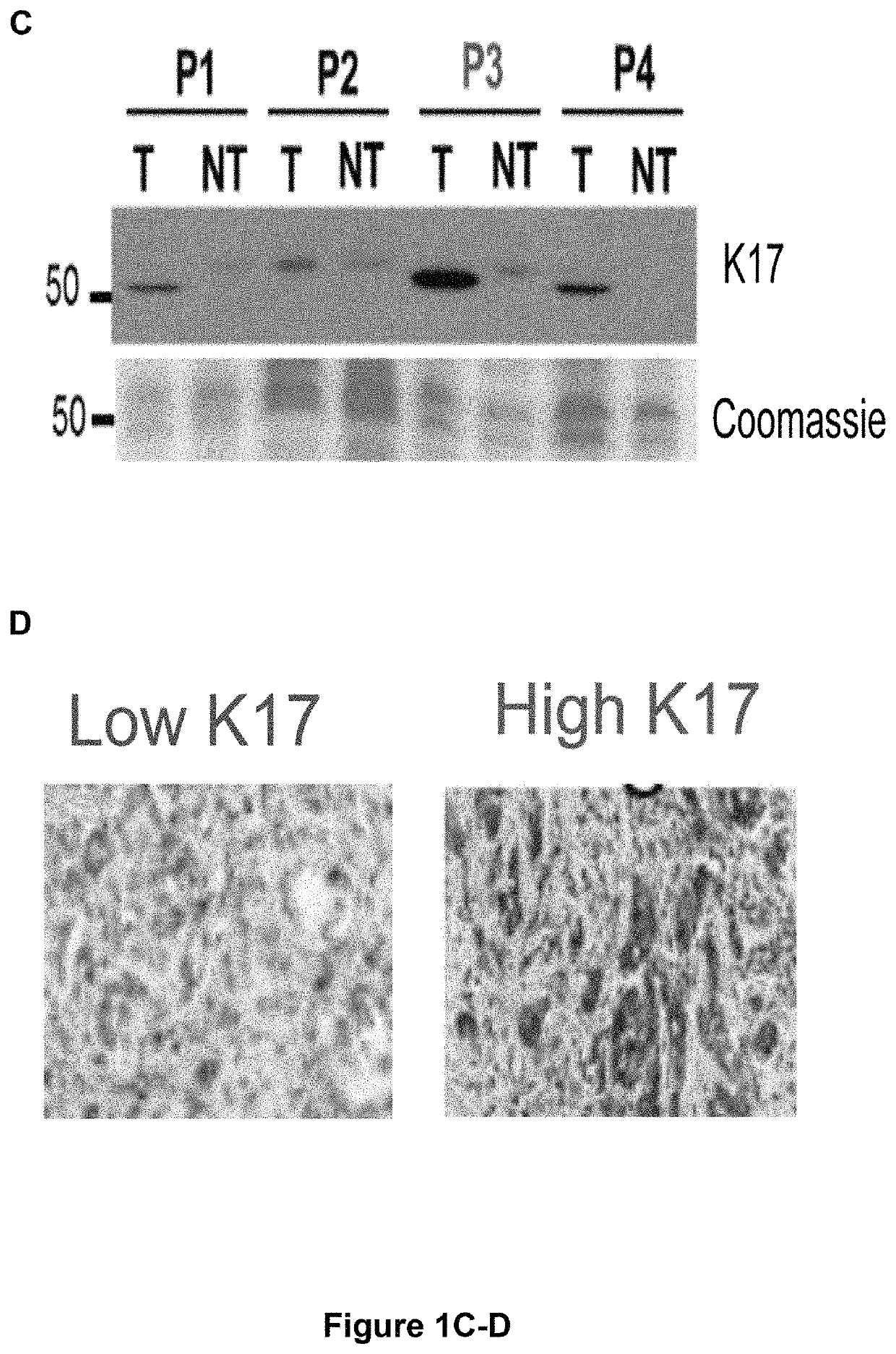Keratin 17 as a prognostic marker for pancreatic cancer
a prognostic marker and pancreatic cancer technology, applied in immunoglobulins against animals/humans, instruments, biochemistry apparatus and processes, etc., can solve the problems of inability to identify independent or interactive prognostic markers associated with known clinical characteristics, pdac patient outcome and/or genetic profiles, and the reason behind the variation in pdac patient survival. , to achieve the effect of reducing survival probability, increasing k17 protein expression, and increasing k17 r
- Summary
- Abstract
- Description
- Claims
- Application Information
AI Technical Summary
Benefits of technology
Problems solved by technology
Method used
Image
Examples
example 1
and Methods
[0066]Patient Tissue Sampling.
[0067]The present disclosure analyzed a patient population including 268 subjects diagnosed with PDAC. A total of 117 formalin-fixed paraffin-embedded surgical tissue blocks from PDAC cases were retrospectively (2008-2012) selected from the archival collections of Stony Brook University and UMass Memorial Medical Center. The criteria for selection were (i) diagnosis of primary PDAC (ii) >18 years at time of diagnosis (iii) and negative resection margins. Patients with a diagnosis of cancer that were primary at other anatomic sites were excluded. PDACs were classified by tumor stage according to the original surgical pathology report. The histologic grade was re-assessed in all cases by a single pathologist. Survival and adjuvant therapy data was obtained from UMass Memorial Cancer Registry and Stony Brook Medicine Cancer Registry. All protocols were approved by the IRBs of both institutions.
[0068]K17 mRNA expression levels were analyzed using...
example 2
haracteristics and K17 Status
[0078]Clinical Characteristics.
[0079]Pancreatic cancer patients that were evaluated for K17 protein expression levels were similar to those evaluated for K17 mRNA expression levels, except that patients evaluated by immunohistochemistry (i.e., protein detection) had longer mean follow-up time. No significant differences in K17 expression levels were found across different tumor stages, tumor grades, primary-tumor size and lymph node status. PDACs were classified as having control (low) K17 expression levels or increased (high) K17 expression levels based on K17 protein or mRNA levels (FIGS. 1A-D and 2A-D). More than half of the pancreatic cancer samples analyzed were determined to have increased K17 expression levels that were, on average 11-times higher compared to corresponding control (low) K17 counterparts (FIGS. 1A-C).
[0080]Mutational analysis of the K17 transcripts detected was conducted. mRNA expression and mutation analysis data showed that K17 i...
example 3
e and Multivariate Analyses for Overall Patient Survival
[0082]The association between a subject's clinical characteristics and K17 expression level with risk of death was assessed by univariate and multivariate Cox regression analyses, the results of which are in Table 1. Univariate and multivariate analyses identified K17 expression level, tumor stage and tumor grade as three independent significant prognostic factors (Table 1), but only K17 expression level was significant in both data sets. Neither primary tumor size, nor lymph node status were associated with a statistically significant increase or decrease overall survival patient survival (Table 1, FIG. 3A-C).
[0083]In contrast, the univariate analysis shown in Table 1 and FIG. 3A-C shows that increased (high) K17 expression coincides with a statistically significant decrease in overall survival patient survival, as evidenced by the approximate two-fold increase in hazard of death after diagnosis. In all multivariate models, co...
PUM
| Property | Measurement | Unit |
|---|---|---|
| survival time | aaaaa | aaaaa |
| color | aaaaa | aaaaa |
| frequency | aaaaa | aaaaa |
Abstract
Description
Claims
Application Information
 Login to View More
Login to View More - R&D
- Intellectual Property
- Life Sciences
- Materials
- Tech Scout
- Unparalleled Data Quality
- Higher Quality Content
- 60% Fewer Hallucinations
Browse by: Latest US Patents, China's latest patents, Technical Efficacy Thesaurus, Application Domain, Technology Topic, Popular Technical Reports.
© 2025 PatSnap. All rights reserved.Legal|Privacy policy|Modern Slavery Act Transparency Statement|Sitemap|About US| Contact US: help@patsnap.com



